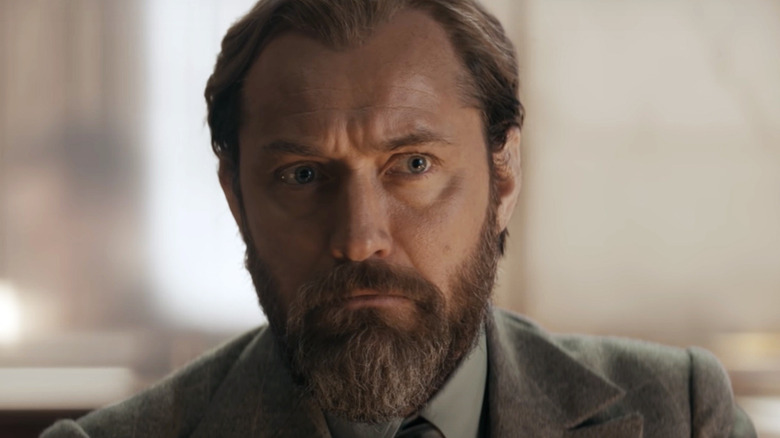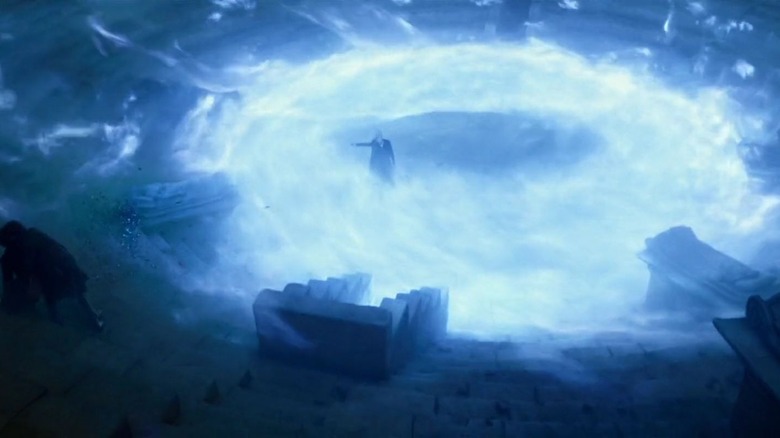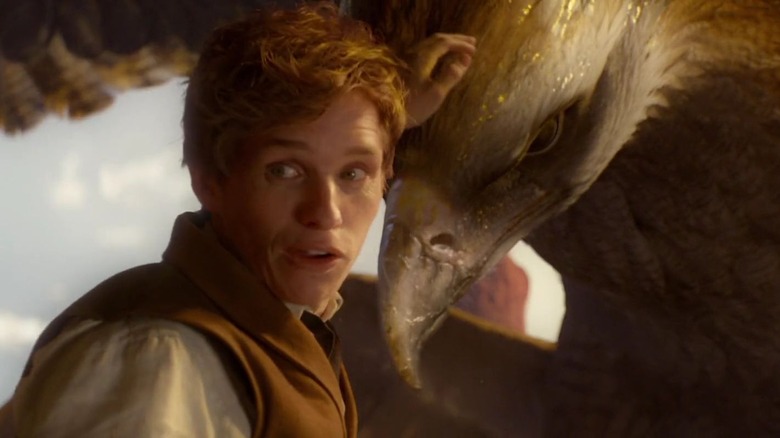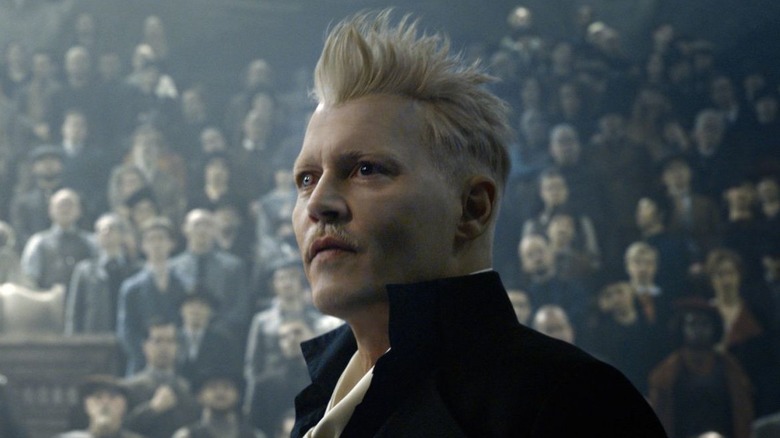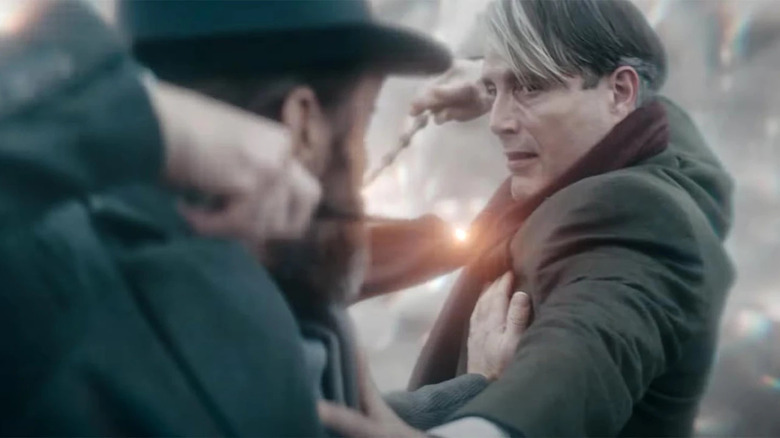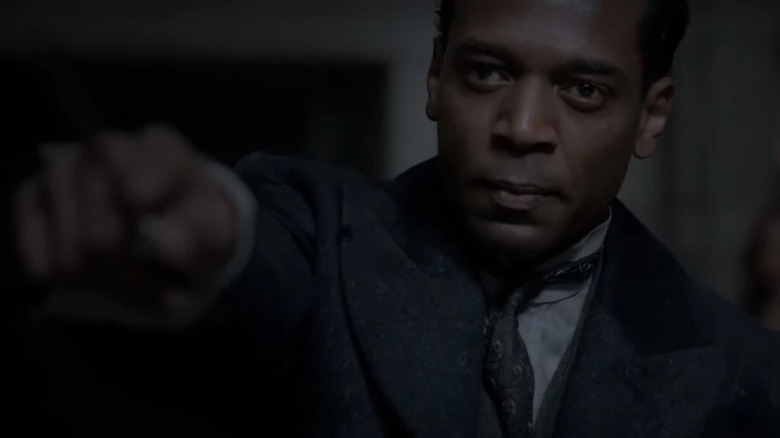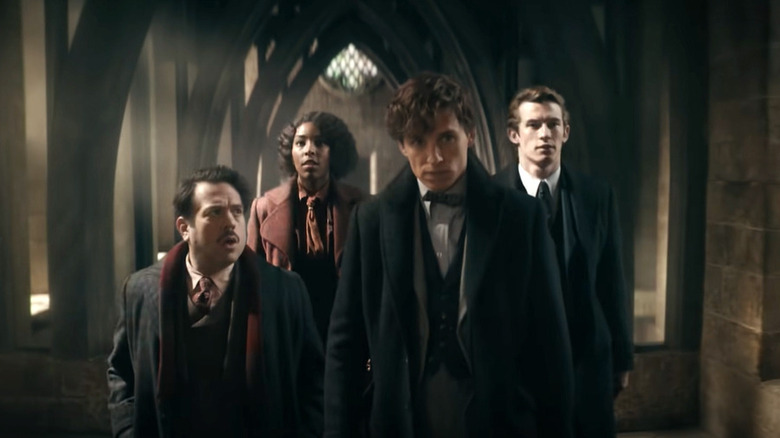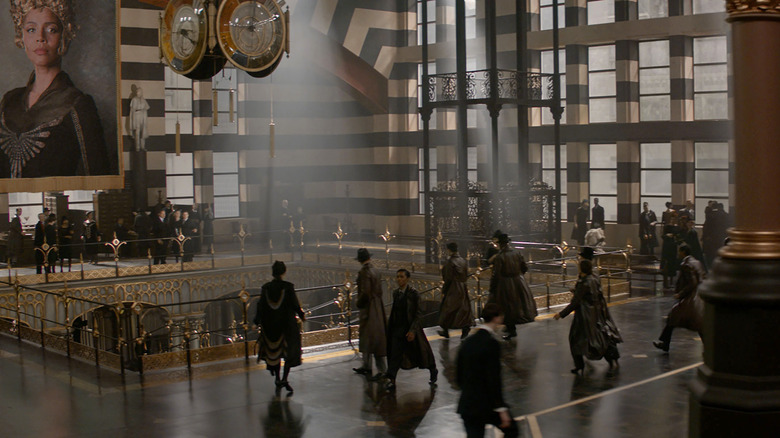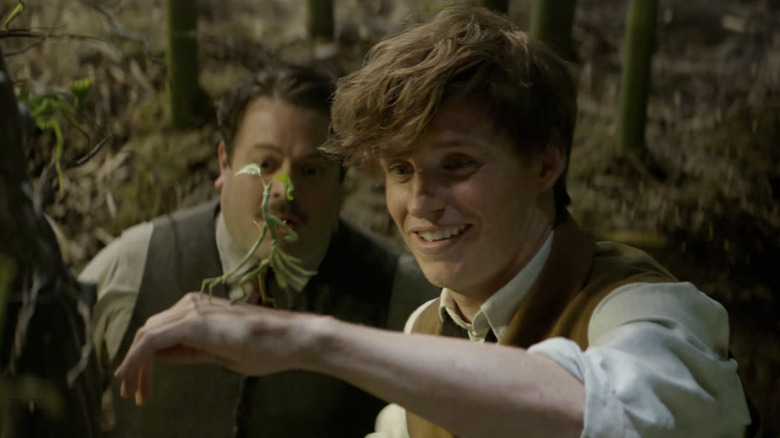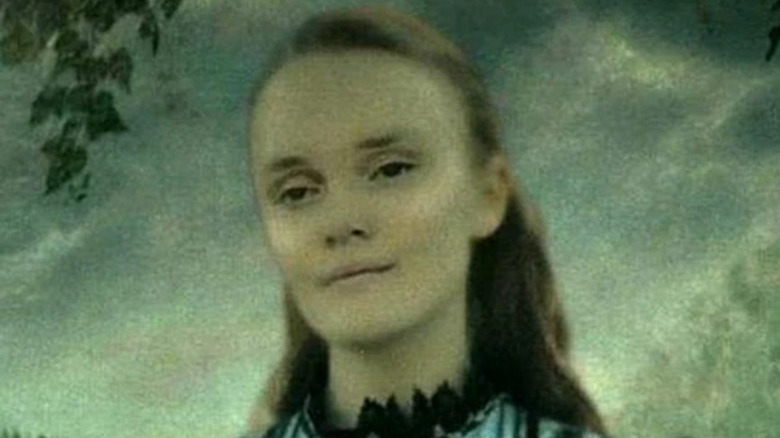Things The Fantastic Beasts Franchise Does Much Better Than Harry Potter
"Harry Potter and the Sorcerer's Stone" might have hit theaters all the way back in 2001, but the wizarding world still has a hold over audiences. The "Fantastic Beasts" movies are a big part of why: They take the magic to entirely new places — literally. 2016's "Fantastic Beasts and Where to Find Them" travels far beyond the bounds of Hogwarts to New York City of the 1920s, where Newt Scamander (Eddie Redmayne) must fight to keep his beloved creatures safe. 2018's "Fantastic Beasts: The Crimes of Grindelwald" introduces even more tension into the mix, while 2022's "Fantastic Beasts: The Secrets of Dumbledore" brings things to an explosive head.
While both the "Fantastic Beasts" and "Harry Potter" franchises take place in the same world and share certain characters, they tell very different stories. Though it might shock some fans to hear it, we think the former series might even improve upon the latter. These are the things "Fantastic Beasts" does much better than "Harry Potter."
More impressive magic
Although the "Harry Potter" movies introduce cinephiles to the wizarding world, they're largely restricted to roaming the halls of Hogwarts. This never allows audiences to see the true power witches and wizards possess. Granted, Voldemort (Ralph Fiennes) and Dumbledore (Michael Gambon) have an exciting magical duel in "Harry Potter and the Order of the Phoenix" that showcases what two elite practitioners can accomplish, but it only lasts a mere few minutes.
In contrast, the "Fantastic Beasts" franchise treats audiences to massive displays of magical power. We see magic that can shatter huge sheets of glass, revert objects back to their original forms, and seal one's mouth shut. The most impressive spell introduced thus far arrives when Grindelwald casts Protego Diabolica. A powerful dark charm that manifests as a circle of fire around the caster, it allows his allies to pass through without danger, while his enemies are burnt to ash.
These additions show just how magical the Wizarding World truly is. But it does beg the question why Harry and crew never use any of these amazing spells when fighting Voldemort. Maybe they were all going to be taught during their scrapped seventh year?
More magical creatures
While the "Harry Potter" franchise boasts detailed dragons, werewolves, and hippogriffs, audiences don't get to see most of the magical creatures that are mentioned throughout the series. And when we do see these unique beings, they're typically depicted as aggressive and even violent. This is where the "Fantastic Beasts" franchise really steps it up. As their titles suggest, these films showcase various beasts that live within the wizarding world. Newt acts as a major advocate for protecting and relating to these misunderstood creatures.
This unique take on magical beasts begins in the first film, as Newt travels from London to New York in the hopes of releasing a Thunderbird back into the wild. He states that he rescued the creature from captivity in Egypt. It's lucky he did, as the Thunderbird is able to disperse a potion that erases recent memories all over New York City after Grindelwald exposes the wizarding world. The Thunderbird isn't just gorgeous — it's helpful. Thus, the "Fantastic Beasts" franchise does an excellent job of changing the narrative regarding magical creatures.
Presenting multiple viewpoints
The events of the "Harry Potter" series are mostly told from Harry's (Daniel Radcliffe) point of view. In contrast, while the "Fantastic Beasts" franchise does have a protagonist in Newt, audiences are offered multiple points of view over the course of its films. Because of this, the story told in "Fantastic Beasts" is uniquely well-rounded. Audiences are able to see the wizarding world through many different characters' eyes, rendering every conflict a complex affair.
This multifaceted approach makes the bad guys even scarier, because they seem all the more plausible. For example, Grindelwald (Johnny Depp, Mads Mikkelsen) is portrayed as being both charismatic and idealistic and truly awful, depending on the point of view. Unlike Voldemort, he doesn't always use fear to get his way — he calmly manipulates people, who feel genuinely charmed and intrigued by what he offers. Because of this, Grindelwald is an incredibly effective villain: The fact that he's comprehensible makes him far more terrifying.
Exploring Dumbledore's past
While the books detail it a bit more than the films do, the passionate relationship between Dumbledore and Grindelwald is only ever alluded to in the "Harry Potter" series. "Fantastic Beasts: The Secrets of Dumbledore," on the other hand, seizes the opportunity to explore how these two characters were brought together through their interest in the Dark Arts, and how their bond splintered.
"Harry Potter and the Deathly Hallows" invokes Dumbledore and Grindelwald's shared obsession with finding the titular items, but readers and audiences never get the chance to see them interact. "Fantastic Beasts" remedies this. Dumbledore's (Jude Law) deepest desire is revealed to be Grindelwald, as seen when he looks into the Mirror of Erised. "Fantastic Beasts: The Secrets of Dumbledore" goes into further detail, eventually pitting the two wizards against each other. Viewers come to grasp the full scope of Dumbledore's loss through this film, which deepens his character arc and the "Harry Potter" franchise as a whole. While Dumbledore is an important character in the "Harry Potter" series, "Fantastic Beasts" allows us to get to know him, and his relationship with Grindelwald, in an entirely new way.
Greater representation
With characters such as Leta Lestrange (Zoë Kravitz), Yusuf Kama (William Nadylam), and Nagini (Claudia Kim), "Fantastic Beasts" is a far more diverse series than "Harry Potter." People of color hold important positions in this depiction of the wizarding world, and play key roles in various storylines. While the "Harry Potter" series isn't an entirely white affair, most of the saga's main characters are. "Fantastic Beasts" offers a welcome change.
However, it's important to note that some critics have called "Fantastic Beasts" out for stereotypical casting choices. As Megan C. Hills argued in Marie Claire, this is especially frustrating in the case of Claudia Kim, who plays Nagini. The "Fantastic Beasts" movies reveal Voldemort's snake to be a Maledictus. Essentially, a Maledictus is a woman who carries a blood curse from birth, which eventually forces her to permanently transform into a snake. Hills argues this reinforces stereotypes of Asian women as subservient, as Nagini eventually becomes Voldemort's pet, servant, and horcrux.
A more adult tale
For the most part, the "Harry Potter" franchise takes place at Hogwarts and is seen through the eyes of a young student. Many fans have been able to mature alongside Harry as his story moves away from childlike wonder towards the ravages of war. This is a wonderful thing — but "Fantastic Beasts" offers something a little different grown-up fans deeply appreciate.
Instead of kids and teenagers, the "Fantastic Beasts" franchise is centered around adults. While there are many adults in the "Harry Potter" saga who help Harry on his journey, it's very much his story, and mostly involves his peers. "Fantastic Beasts," in contrast, brings adults to the forefront. Audiences see characters make decisions that affect the wizarding world as they balance careers, regrets, families, and romances. It brings new depth to the universe, and, to be honest, feels more realistic — the world does usually rest on the shoulders of grown-ups, rather than teenagers.
An expanded wizarding world
Throughout his series, Harry Potter is always amazed by the everyday actions of the wizarding world. This is especially clear when he visits his best friend Ron (Rupert Grint) and his family, the Weasleys. The Weasleys are a pure-blood wizarding family that is completely immersed in the magical world: Just as Harry is amazed by their self-stirring sauces and flying brooms, the Weasleys (especially Arthur Weasley) are bewildered by ordinary Muggle inventions like electrical sockets.
Until the "Fantastic Beasts" films premiered, Harry's stays with the Weasleys were the only real look audiences ever got at how witches and wizards live their lives. But through characters like Tina (Katherine Waterston) and Queenie (Alison Sudol), fans get to see how magic is fully integrated into their lives. In this franchise, audiences even leave the United Kingdom altogether to see how the wizarding world runs in other countries. While Hogwarts remains important, these films primarily focus on how the American magical community governs itself, which turns out to be a pretty different affair. Moreover, most of the franchise's characters aren't newbies like Harry. What results is a complex portrait of magical life, in all its mundanity and amazement.
A Hufflepuff hero
Aside from Cedric Diggory (Robert Pattinson), Hufflepuff house never really gets much recognition in "Harry Potter." Between Slytherins' ambition and cunning, Gryffindors' bold bravery, and Ravenclaws' fierce intelligence, Hufflepuffs simply get lost in the shuffle. They're distinguished by their kindness and loyalty, sure, but they're kind of just along for the ride, as far as the story goes.
"Fantastic Beasts" allows Hufflepuff to step into the limelight, however, as series protagonist Newt Scamander hails from that noble house. His Hufflepuff qualities are a big part of what makes him so heroic, too: It takes someone from the house known for its warm-heartedness to earn the trust of so many magical creatures. Newt's importance to the saga as a whole is also pretty huge: His grandson Rolf Scamander ends up marrying Ravenclaw fan-favorite Luna Lovegood (Evanna Lynch). Moreover, Newt is also the author of the in-universe textboot "Fantastic Beasts and Where to Find Them," which Hogwarts students study during Harry's time at school. 10 points to Hufflepuff!
Ariana Dumbledore's story
In "Harry Potter and The Deathly Hallows," Harry discovers Dumbledore and Grindelwald's complex history. These two wizards came to believe their power gave them the right to rule, and that they could accomplish their lofty goals through the Deathly Hallows. Tragically, things fell apart, and eventually came to a brutal crescendo when Grindelwald, Dumbledore, and Dumbledore's brother Aberforth dueled each other. When the smoke cleared, the Dumbledores' younger sister Ariana was dead.
The "Fantastic Beasts" franchise brings entirely new depth to Ariana's tragic tale. Attacked by a group of boys at a very young age, Ariana was traumatized to the point of becoming an Obscurial. An Obscurial (a concept introduced in the "Fantastic Beasts" films) is a witch or wizard whose magic has been suppressed, often through abuse. Turned inward, their powers grow uncontrollable and poisonous, eventually killing them. Watching this process eat Ariana alive was horrific, as Dumbledore recalls in "Fantastic Beasts: The Secrets of Dumbledore." Fans knew about Ariana's sad fate before this third film hit theaters, but they'd never seen it explored in such potent detail.
